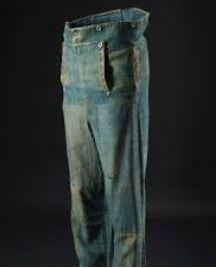Levi Strauss, From Immigrant Peddler to International Icon
In the mid-19th century, Levi Strauss was responsible for bringing one of the world’s most durable clothing items to market: denim blue jeans. Levi Strauss would become a household name as his distinctly American invention — an enduring symbol of cowboy and frontier life in the 1800s, of Beat ‘cool’ in the 1950s, hippies in the 1960s, and punk rebellion in the 1970s and beyond — became an international success. While most associate the invention of the blue jeans with the California Gold Rush and the American West, Strauss himself and Levi Strauss & Co. have roots right here in our neighborhood, today’s East Village and the Lower East Side.

Levi Strauss was born to an Ashkenazi Jewish family on February 26, 1829, in the Franconia region of the Kingdom of Bavaria in the German Confederation. Due to harsh Anti-Semitic laws and violence, at the age of 18 he immigrated to the United States with his mother and two sisters to join his brothers who had begun a wholesale dry goods business in New York City. J. Strauss Brother & Co. was located at 108 Liberty Street in Lower Manhattan.
Working for the family business, Levi was a peddler. He walked New York’s streets selling sewing goods, blankets, and kettles.
By 1853, the family resided at what was then called 165 Houston Street, when Levi’s brother Louis signed Levi’s citizenship paperwork. 165 Houston Street was listed in the New York Directory as both the residence of Jonas Strauss and J. Strauss & Brother Dry Goods. In 1853 Levi was selling his brothers’ supplies in Louisville, Kentucky.

165 Houston Street was located on the north side of Houston Street between Avenues B and C. Several years later, Houston Street was renumbered and 165 Houston Street became 372 East Houston Street. The building was likely demolished when Houston Street was widened to accommodate cars in the early 1930s.

Birth of the Blue Jean
The Strauss family, as well as hundreds of thousands of other fortune-seekers from around the world, set their sights on California. Levi arrived in San Francisco, the commercial center of the Gold Rush, in March 1854.
Levi sold a wide variety of products, including a sturdy imported heavy cotton fabric, denim. One of his customers was a tailor named Jacob W. Davis. Davis used Levi’s denim fabric in his business, where he produced rugged items like tents, horse blankets and wagon covers. Around 1870, Davis was commissioned by a mining company to create sturdy work clothing. He used denim, hammering rivets onto the pocket corners to make them more durable.

In 1872 Davis proposed a partnership with Levi Strauss & Co. On May 20, 1873, Strauss and Davis received their patent to create work pants reinforced with metal rivets, marking the birth of one of the world’s most famous garments: blue jeans.
The rugged clothing became popular with the miners, farmers, and other laborers. By the end of 1873, thousands of San Franciscans were wearing Strauss and Davis’s denim jeans, overalls and work clothing. The company would later register the name “Levi’s” as a trademark.
The Legacy
Blue jeans would of course go on to sweep across the globe as a fashionable and utilitarian item of clothing, as well as a symbol of the American West, ingenuity, and freedom. Strauss and Davis’s patent expired in 1890, which allowed other manufacturers to reproduce the style and by the start of the 20th century, “jean” was the term for a wide range of denim trousers.

In the 1920s and 1930s Hollywood began to romanticize blue jeans by dressing John Wayne and Gary Cooper in them. In the 1930s Vogue called jeans “Western chic” and actresses such as Ginger Rogers and Carole Lombard wore them publicly. The style became extremely popular.

In the 1950s teenage sex idols such as Marlon Brando and James Dean caused jeans to become associated with rebellious, anti-establishment youth. In the 1960s and 70s hippies and protestors wore jeans as a way to show support for the working class, while feminists and women’s rights organizers wore them to demonstrate gender equity. In the late 1970s and 80s, the back-to-basics punk aesthetic embraced jeans, especially the original, Levi’s, as an emblem of the essential elements of utility and cool. Local bands like The Ramones, Blondie, the Talking Heads and Television resurrected the simple basic Levi jeans as a downtown fashion necessity, inadvertently bringing this clothing accessory back to its geographic roots more than a century later. Jeans became a symbol of the counterculture and were actually banned by some schools.

Calvin Klein was the first designer to use jeans on the runway, in 1976 In the 1980s and 90s, jeans were sold by high end designers such as Versace, Dolce & Gabbana and Dior.

Styles have evolved constantly over the decades, bellbottoms, acid-wash jeans, black jeans, baggy jeans, skinny jeans, just to name a few. Jeans are now available in a multitude of design styles on all sides of the spectrum from mass produced to luxury labels, and of course, the original brand of Levi’s.
